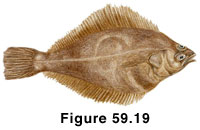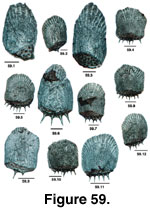 Description
Description
Psettichthys melanostictus
(Sand Sole)
(Other common names: Fringe Sole; Sand Flounder, Spotted Flounder)
Figure 59.19
 Description
DescriptionLength: 63 cm.
Mouth: large, terminal; wide gape; almost symmetrical; maxillary extends to point below pupil of eye.
Body: caudal peduncle deep and flat; caudal fin rounded; first eight (or more) rays on dorsal fin elongated and not attached to fin membrane; anal fin spine directed anteriorly; pectorals small; lateral line slightly arched over pectoral region then straight; accessory dorsal branch present.
Color: variable; green to brown with black points on eyed side; yellow on the tips of the dorsal and anal rays.
Depth: up to 183 m.
Habitat: sandy substrate; generally in shallow waters.
Season: spawning occurs winter-early spring (January-March).
Diet: forage fish species (e.g., anchovies, herring, speckled sanddab), crustaceans, worms, and molluscs.
Predators: not determined.
Distribution: southern California to Alaska to the Bering Sea.
 Scale Description
Scale DescriptionType of Scale: ctenoid on eyed side; cycloid on blind side, except on ventral edge where there are some ctenoid scales.
Relative Scale Size: small.
Position of Scales on Body: base of dorsal, anal, and caudal fins; 98-112 scales along the lateral line; imbricated (Hart, 1973).
Overall Scale Shape: generally oval with elongated lateral sides; the C and E scales are more squared. Area of anterior field is larger than area of combined lateral fields (Batts, 1964). Bar-like thickening is anterior to the base of the ctenii. Ratio of base of ctenii to the length of the longest ctenium is approximately 1:2 (Batts, 1964).
Focus and Circuli: the focus is not centralized, and is positioned approximately one-fourth to one-fifth (Batts, 1964) from the outside margin of the posterior field (in both ctenoid and cycloid scales), is close to but does not abut ctenii basal area. The circuli are compact and continuous in the anterior-lateral fields (Batts, 1964); discontinuous in the posterior field (both cycloid and ctenoid).
Radii: numbers are variable and not diagnostic. The radii are present only in the anterior field (Batts, 1964). The outer edge of the anterior field is smooth, not scalloped. Intermarkings absent (Batts, 1964).
To date, no flatfish scales have been found in our core analyses. The scales of both groups of flatfish are sufficiently robust to withstand the preservation process, but since Effingham Inlet bottom waters are anoxic, it is unlikely that flatfish would inhabit that part of the basin and hence, scales do not show up in the laminated regions. Sediments deposited during oxygenation episodes in these basins have yet to be examined so representatives of the flatfish may be present in these portions of the cores.